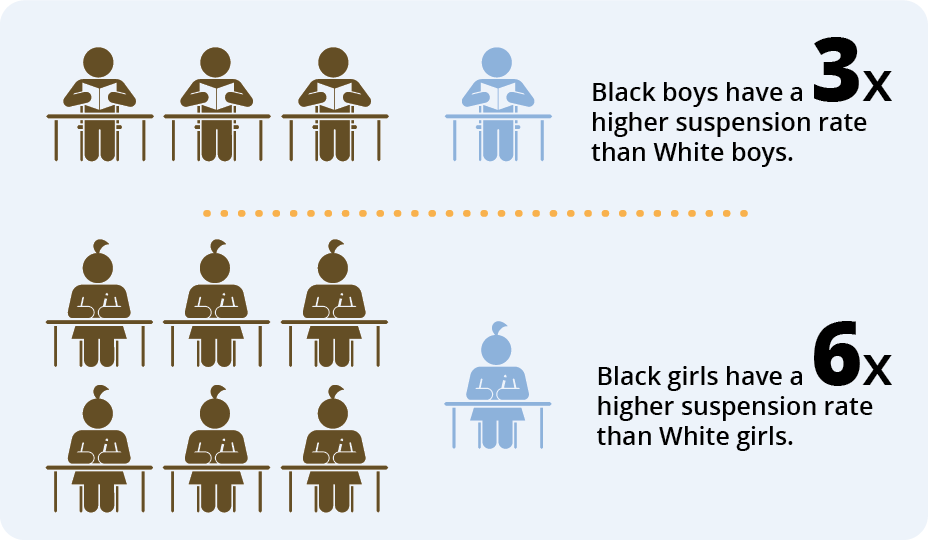Authors: Minhae Cho, Young Ji Yoon, Ndilimeke Nashandi, Dr. Priscilla Gibson, and Dr. Wendy Haight
Out-of-school suspension (OSS) is a temporary, complete exclusion from school for responding to students’ misbehaviors up to ten school days. Many public schools persist in using suspensions as a standard practice even though they are largely ineffective in deterring these behaviors and associated with negative outcomes, including failure to achieve academic standards, grade retention, school dropout, and entry into the juvenile justice system.
Racial disproportionality in out-of-school suspension is also concerning. In Minnesota public schools, results from Racial Disproportionality Indexes (RDI) indicate that Black students are represented in out-of-school suspension 4 times the rate of the general population. Black (RDI: 4), Native American (RDI: 3) and Hispanic (RDI: 1.7) students were overrepresented in out-of-school suspension while White (RDI: 0.6) and Asian (RDI: 0.4) students were underrepresented. When the same results are disaggregated by gender, the disproportionality indexes show that Black boys (RDI: 4.7), Native American boys (RDI: 3.6) and Black girls (RDI: 3.2) are overrepresented. RDIs for Hispanic boys (RDI: 2.2), Native American girls (RDI: 2.1), Hispanic girls (RDI: 1.1), White boys (RDI: 0.9); Asian boys (RDI: 0.6), Asian girls (RDI: 0.2) and White girls (RDI: 0.2) are represented two times the rate of the general population and below.
During the 2009 -2010 academic year, 5.5% of the 7th graders enrolled in Minnesota public schools were suspended, and of all suspended students 71.2% were male. Of the suspended students, 71.2% were males. Overall, a majority of the suspended students (60%) were from low-income families. The proportion of suspended students from low-income families almost doubled that of all Minnesota public school students (29.2%). Suspended students (29.5%) were disproportionately represented in individualized education plans (IEPs) compared to 11.2% of all Minnesota public school students. On average, 13.6% of the suspended students were officially diagnosed of emotional and behavioral disabilities (EBD). The difference in academic achievement between black and white groups was also prominent. Approximately, 60% of the Black boys and girls compared to a third of White boys and girls did not meet state competency standards in reading and math. The relatively higher percentage of Black boys (13.3%) and girls (8%) were from either immigrant or refugee families compared to White boys (0.6%) and White girls (1.4%).
 Although the suspension of Black boys has been an issue of concern, less attention has focused on Black girls. Nationally, Black boys are suspended at a rate three times higher than the rate for White boys, but Black girls are suspended at a rate six times higher than the rate for White girls. To effectively address the persistent problem of racial disparities affecting black girls in out-of-school suspensions, it is important that we develop prevention and intervention efforts to work with caregivers and educators.
Although the suspension of Black boys has been an issue of concern, less attention has focused on Black girls. Nationally, Black boys are suspended at a rate three times higher than the rate for White boys, but Black girls are suspended at a rate six times higher than the rate for White girls. To effectively address the persistent problem of racial disparities affecting black girls in out-of-school suspensions, it is important that we develop prevention and intervention efforts to work with caregivers and educators.
In-depth, individual, semi-structured interviews with Black girls suspended from school and their caregivers and educators revealed their unique relational challenges with adults at school. Black girls are pathologized in school, in ways that undermine their psychosocial development and educational success. Pathologize refers to a process that treats differences as “shortfalls” and leads to discriminatory policies and practices (Gibson, Wilson, Haight, Kayama, & Marshall, 2014). Black girls’ suspensions result primarily from a breakdown in relationships with adults at school. Educators view Black girls, negatively and behave towards them discrepant with their self-perceptions and experiences in their communities. Educators ignore or minimize Black girls calls for help, especially around issues of verbal harassment, considering those issues as “Black girl drama.” Policing Black girls physical appearances or expressiveness of their communications results in the silencing of their voices in school. One educator described a Black girl:
“Um, shapely little girl, right? So she comes in with her tight little tube-, spandex pants and provocative kind of tops and so you knew you were gonna have that with the new girl coming in town. And, so now she’s just kinda been under the radar. I said to her in a gentle voice, “Shut your mouth, that’s all, you don’t always have to say something when somebody says something to you.”
Black girls are self-aware about racism and sexism in school, and resist through positive behaviors encouraged by a community of allies such as parents, teachers and other Black girls. Treating Black girls differently in schools undermines their psychosocial development and educational success. Providing safe spaces in schools and increasing educator’s awareness of the intersection of race and gender in the out-of-school suspension practice can foster girls’ critical consciousness and promote positive peer support for school success.
It is imperative to understand the direct connection between out-of-school suspensions for Black girls and their overrepresentation in the child welfare system. Regular school absence and suspension can lead to truancy intervention. Learn more about racial disproportionality in out-of-school-suspension in the following articles:
- Gibson, P. A., Wilson, R., Haight, W., Kayama, M., & Marshall, J. M. (2014). The Role of Race in the Out-of-School Suspensions of Black Students: The Perspectives of Students with Suspensions, their Parents and Educators. Children and youth services review, 47, 274-282.
- Losen, D.J. (2011). Discipline Policies, Successful Schools, and Racial Justice. Boulder, CO: National Education Policy Center. Retrieved from http://nepc.colorado.edu/publication/discipline-policies
To learn more and for additional resources related to risks and protections for Black girls’ out-of-school suspension follow our Facebook and Twitter accounts for daily posts over the next week. Follow the hashtag #suspensionBlackgirls.